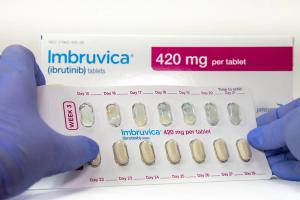
Myeloproliferative neoplasms–unclassifiable (MPN-U), show distinct genetic and clinical patterns that differentiate them from essential thrombocythemia.

Myeloproliferative neoplasms–unclassifiable (MPN-U), show distinct genetic and clinical patterns that differentiate them from essential thrombocythemia.

Synovial sarcoma—a rare, aggressive soft tissue cancer—can present as a painless hand swelling that mimics a harmless lesion, underscoring the need for early recognition and improved diagnostic access in low-resource settings.

CD45 + C1q + CCR8+ cells were found to be a novel immune-cell subset associated with kidney disease severity and progression risk.

Patients with fatty liver disease are significantly more likely to develop kidney stones, a national study found.

Dana-Farber researchers have uncovered mutation pathways driving aggressive disease transformation.

Researchers developed a first-of-its-kind panel to track receptor expression and predict therapy response.

The study highlighted pain, fatigue, and functional status as key early warning signs.

Emotional well-being and social engagement significantly impact quality of life for patients with soft tissue sarcoma post-surgery.

Weight loss medications show promise in improving liver health for those with chronic liver conditions, a review found.

Electronic health record (EHR)–based “e-phenotypes” combining lab data, coding, and AI could dramatically improve early detection and management of chronic kidney disease.

The study confirms that biologics are highly effective in real-world HS management, and highlights the need for a comprehensive treatment strategy considering both skin symptoms and systemic health.

A phase 1b trial of tarlatamab plus PD-L1 inhibitors in extensive-stage small-cell lung cancer (ES-SCLC) showed a median overall survival of 25.3 months with manageable safety.

Four autophagy-related variants in CDKN2A and BCL2 may increase susceptibility to chronic lymphocytic leukemia (CLL).

Oral nicotinamide reduced the risk of new skin cancers—especially squamous cell carcinoma—by up to 54% when started after a first diagnosis.

As oncology continues to move more toward precision medicine, tools like EVOFLUx may offer a more personalized roadmap from diagnosis to treatment.

Positive topline data from the phase 3 BRUIN CLL-313 showed pirtobrutinib's efficacy in the frontline setting.

This case highlights the diagnostic complexity and clinical management challenges of dual hematologic malignancies.

Ruxolitinib cream 15 mg/g provided rapid, meaningful repigmentation and improved quality of life for adults with nonsegmental vitiligo.

Drug interactions with ibrutinib may not shorten survival when managed carefully, though the significant increase in infection-related hospitalizations tied to CYP3A inhibitors signals an urgent need for closer monitoring, dose adjustment, and proactive infection prevention strategies.

Among survey respondents, approximately 80% reported experiencing stigma, including feelings of embarrassment, negative judgment, or being treated differently, because of their condition.

As the prevalence of both chronic kidney disease (CKD) and heart failure (HF) increases, therapies targeting shared pathways are one of the most promising strategies to alter the trajectory of these diseases.

The findings add confidence to the role of ritlecitinib as a treatment option for severe alopecia areata while pointing the way toward more personalized approaches.

While observational studies have previously pointed to an association, being able to identify causation has been difficult due to overlapping risk factors and confounding variables.

Strategies that combine ferroptosis inhibition with established antifibrotics could ultimately move treatment from slowing progression to truly reversing fibrosis, new research suggests.

As the prevalence of chronic kidney disease (CKD) continues to rise, empowering primary care providers (PCPs) with the tools, training, and collaborative frameworks needed for optimal management is a public health priority, emphasize the researchers.

Hair and scalp disorders in patients with skin of color are frequently misdiagnosed, often due to educational gaps and premature diagnosis, with scalp biopsy proving more reliable than trichoscopy for accurate diagnosis.

A cumulative review offers strong evidence that acalabrutinib has a low incidence of cardiac failure in both clinical trial and real-world settings.

A recent study suggests hemorrhagic events following essential thrombocythemia diagnosis are among the most significant predictors of early death.

Real-world data support the effectiveness of combining platinum-based chemotherapy with PD-1 inhibitors for recurrent limited-disease small cell lung cancer (SCLC), enhancing patient outcomes.

With limited treatment options and potential for admission to the intensive care unit, researchers of a new paper highlighted the importance of discussing goals and initiating palliative care early on.

Published: September 23rd 2025 | Updated:

Published: June 13th 2024 | Updated:

Published: May 22nd 2025 | Updated:

Published: March 28th 2024 | Updated:

Published: May 1st 2025 | Updated:

Published: April 6th 2024 | Updated:

259 Prospect Plains Rd, Bldg H
Cranbury, NJ 08512
© 2025 MJH Life Sciences®
All rights reserved.
